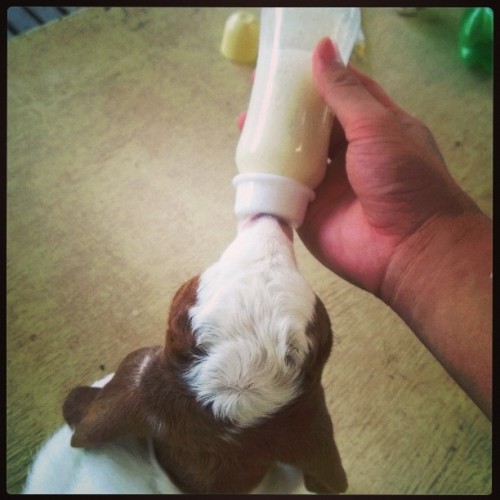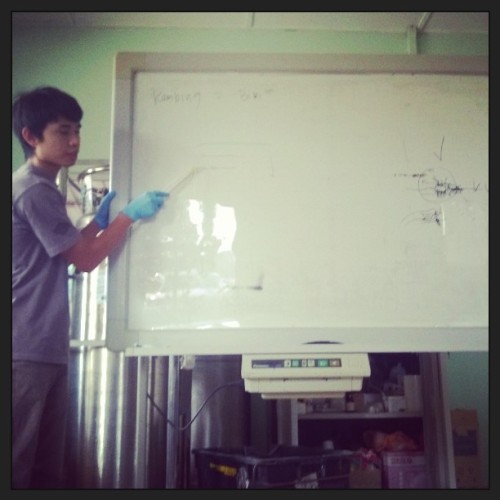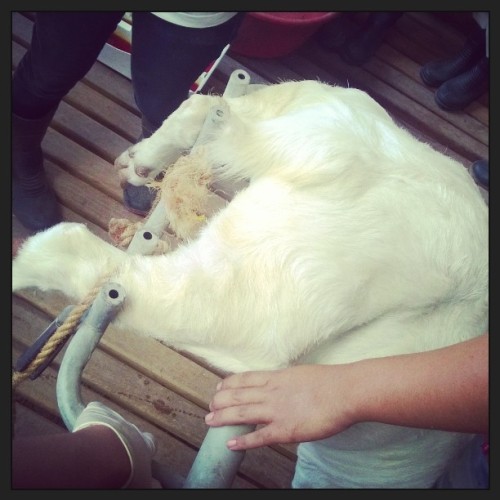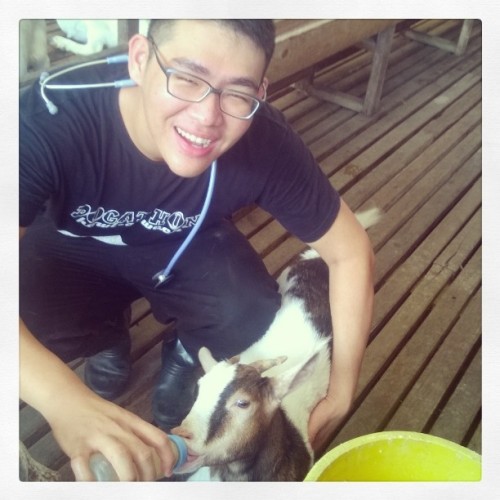I stepped into the farm a few days later from the intended period due to a seminar held by the student affairs department for club presidents.
Well, I definitely have learned a lot in etiquette of dining in official dinners; but apart from that everything else was pretty redundant.
Stepping into the farm on Wednesday afternoon; the farm had a good vibe from its surrounding and the supporting staffs.
I officially began on Thursday, because it was already 5pm when I reached the farm in Wednesday. No thanks to Jung who kept me acquaintanced up till 3pm; or was it the other way round?
Mornings were pretty much the same everyday. We patrol the particular pent we are in charge of , faithful number 9 to see if there are any anomalies in the pent like:
1- weak kids
2- weak does
3- scabbies
4- coughs signing pneumonia
There were a few cases of labor death a week before we arrive so there is a bunch of kids which are being fostered , another bunch which only feed on milk replacers.
What we do is make sure the fostered kids get enough milk for the morning; or day by bringing them to foster does to suckle enough milk. Some does can be a pain in the ass for not allowing the kids to suckle because they are technically, not their offspring.
Milking the does seemed to be the funnest thing to do, especially when the teats are filled with milk and each squeeze brings down about 50ml of fresh goat milk.
Not like we can drink them off like that because they ain't pasteurized; plus the milk is for the kids.
Basically; mornings are pretty much nanny duties.
Only on the Saturday morning, we had a lot of fun handling a case of dystocia(difficulties in labor) The doe had a hard time pushing the kid out of her uterus, so we had to step in. Me being the one with largest hand couldn't do anything because the vulva of the doe was thatttt small. All I can do is aid in holding the doe in position while Lady Boss try her best in pulling out the kid from the shoulder. After 30 minutes of drama we managed to get the kid out, make it stand and keep it breathing because it stopped half way through. It was frantic, but certainly a great experience.
Fun stuffs come in the afternoon when the active vet have the time to be around us. Thursday was dull because the doctor had to attend to a course hosted by the farm.
On Friday, we get to look into the does which have been in the estrous synchronization program 17 days before to remove the CIDR-G(Coated Internal Drug Release for Goats). For laymen, estrous sync is a way for human to manipulate the estrous(similar to menstrual cycle in human) cycle in the animals to achieve a controlled time of ovulation in a herd of animals. It's an economical way for better records, herd health, herd uniformity for feed providence, and even manageable inseminating practice.
The does with CIDR-G removed are given injections of Pregnant Mare Serum Gonadotrophin(PMSG) to induce ovulation, which usually takes 48 hours for effect. Meaning, Artificial Insemination is best done on Sunday.
On Saturday, we looked into the kids and does in pent 9 to see if there are treatments to be given;
1- weak calves are given vitamins and calcium to boost their strength biochemically.
2- weak does are given vitamins and calcium also to boost strength; antibiotics if there are signs of exudative mucus while NSAIDs are given if they show signs of pain and lameness in their joints and hoofs.
3-Scabbies are treated with Ivermectin according to the weight of the animals.
4- Pneumonia suspected cases are treated with higher strength antibiotics like oxytetracycline.
Over the hour before we end our shifts, we had a session with another vet on the AI program. It gave us a brief outline on what we will do on the next session; encompassing the different methods of estrous synchronization; the methods of artificial insemination; the duration differences and success rates of AI. It was insightful because we only have been exposed to a high cases of cattle AI, practice in goats was really the first and once in a blue moon case. Even the active vet said it has been a while since the last AI.
On Sunday, we finally made it into the pent we have removed the CIDR-G from on Friday. AI in goats is different from cattle in many ways:
1- In cattle, crushes are used in which the cattle is sent into a confined space where it can literally, not move. The handlers go to its rear to mend it AI with minimal effort needed to restrain the cattle since the space itself would do the job. In goats, a restrainer is used like an elevated bar to fix the hind legs of the goat, raising its rear while a restrainer will handle the goat by holding it on to place with the body close to the goat's back close to the restrainer. As this is done well, the goat will have its vulva exposed to the person manning the AI.
2- In cattle, AI begins with rectal palpation in which the handler needs to clean the rectum of the cattle, and then stuff the hand into the rectum in order to feel the cervix. The digestive tract of the animal is right above to the reproductive tract, hence the cervix will be palpable by feeling the bottom wall of the rectum when a hard tubing is being felt. In goats, rectal palpation is not possible because of the size of the goat itself being small. Instead, speculum; a duck beak shaped apparatus is being used to retract the vulva and vagina of the goat in order to expose the cervix to the handler. In goats on heat, the cervix will show red flush, and cherry red mass of flesh when exposed using the speculum. Once the handler sees that, cuing of the sperm prep handler can be prompted.
3- In cattle, AI without visual aid requires the palpation of the AI-gun into the cervix of the cattle completely based on experience and feel of the handler of the AI-gun entry. Something which I have yet to master, and need to because chances are so rare. In goat, AI aided with speculum and pen-light gives a good visual of the cervix view, and AI-gun can be inserted into the cervix ridges. There are 3 stages of gun insertion:
a- intravaginal, when the cervix is not opened up large enough to allow smooth gun entry
b- intracervical, when the cervix is opened, but not deep enough for the complete gun entry pass the cervix.
c-transcervical, when the cervix is opened wide enough for the maximal entry of the gun into the uterine cavity.
Insemination depth stages can be gauged by the depth of the gun entry into the speculum by a standard.
Success rate of the AI without visual aid or laparoscope is 60%, with laparoscope can be increased to 80%, but a higher number of apparatus and man power and skill is needed.
Performing AI on goats, an extremely rare experience has gave me a certain enlightenment :
1- Like all cervix, everyone is different in the inside. What we can do is manipulate our way into their lives.
2- Like all cervix, not everyone is that easily entered; or even can be entered. For those, we really don't need to bother
3- Like all cervix, everyone has a depth which they allow entrance. Some allows maximal, some only allow partial; while some none. Cherish those with maximal, be nice to those with partial, let none go.
Time to wait for the babies to conceive!





No comments:
Post a Comment